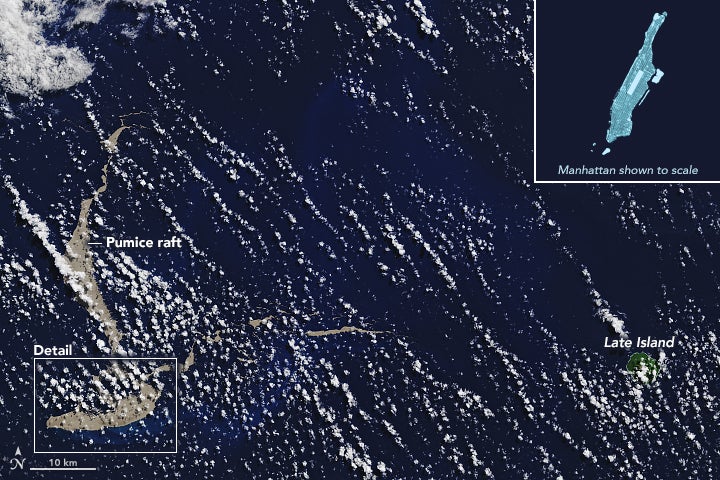Floating 'raft' of pumice rock the size of Birmingham spotted in Pacific
Rocks will reach Australian coast in seven to 10 months where they may replenish damaged Great Barrier Reef

Your support helps us to tell the story
From reproductive rights to climate change to Big Tech, The Independent is on the ground when the story is developing. Whether it's investigating the financials of Elon Musk's pro-Trump PAC or producing our latest documentary, 'The A Word', which shines a light on the American women fighting for reproductive rights, we know how important it is to parse out the facts from the messaging.
At such a critical moment in US history, we need reporters on the ground. Your donation allows us to keep sending journalists to speak to both sides of the story.
The Independent is trusted by Americans across the entire political spectrum. And unlike many other quality news outlets, we choose not to lock Americans out of our reporting and analysis with paywalls. We believe quality journalism should be available to everyone, paid for by those who can afford it.
Your support makes all the difference.A ‘raft’ of pumice rock the size of Birmingham has been spotted in the Pacific ocean.
The floating sheet is more than 150 square kilometres large and was caused by an underwater volcano which erupted near Tonga.
Experts believe that the rocks – some of which are the size of basketballs – will reach the Australian coast in seven to 10 months where they could replenish the Great Barrier Reef, which is being destroyed by coral bleaching.
Michael and Larissa Hoult, who are crew of the Australian adventure catamaran ROAM, found themselves sailing through the mass of rocks earlier this month while on their way to Fiji.
“We entered a total rock rubble slick made up of pumice stones from marble to basketball size,” they wrote on a Facebook post on 15 August.
“The waves were knocked back to almost calm and the boat was slowed to one knot. The rubble slick went as far as we could see in the moonlight.”
The pumice – which forms when molten rocks cool rapidly – comes from an unnamed volcano that is believed to have erupted on 7 August. It last erupted in 2001 and the summit is thought to be 40 metres below the surface.
Ninety per cent of the pumice is underwater and experts have welcomed the discovery, saying the raft could be a home for billions of marine organisms.

“This is some of the newest rock on our planet, only being a few days old,” said Associate Professor Scott Bryan, a geologist from the Queensland University of Technology (QUT).
“The pumice is from an eruption that no one really witnessed. This is a potential mechanism for restocking the Great Barrier Reef.
“Based on past pumice raft events we have studied over the last 20 years, it’s going to bring new healthy corals and other reef dwellers to the Great Barrier Reef,” he said.
Submarine volcanic eruptions such as this are believed to happen once every five years are often completely missed by experts as there is no monitoring equipment to catch the earthquakes before the blast.
This one would probably have gone undetected if it was not for the pumice found in the sea.
Although the pumice is currently bare, Professor Bryan says organisms like crabs and corals will start growing on it in the coming weeks.
“So it will be able to pick up corals and other reef building organisms, and then bring them into the Great Barrier Reef. Each piece of pumice is a rafting vehicle. It’s a home and a vehicle for marine organisms to attach and hitch a ride across the deep ocean to get to Australia,” he said.
This could prove to be a lifeline for the Great Barrier Reef.
Marine heatwaves caused by climate change have caused mass bleaching on around half the corals. A major heatwave in 2016 wiped out 30 per cent of its shallow-water corals in the nine months between March and November that year.
Coral bleaching is linked to global warming and occurs when stresses from higher water temperatures cause the corals to expel symbiotic photosynthetic algae, draining them of all colour and eventually causing them to die.
Bleaching is becoming an increasingly common phenomenon, spelling disaster for coral reefs across the world.
Join our commenting forum
Join thought-provoking conversations, follow other Independent readers and see their replies
Comments